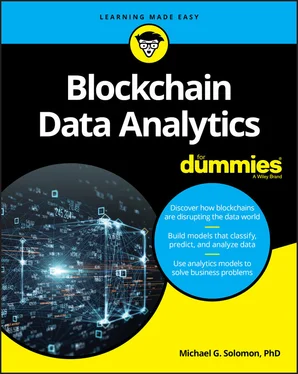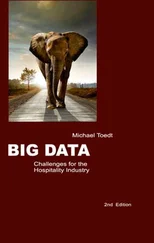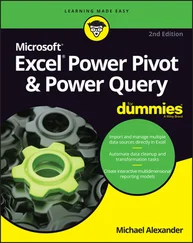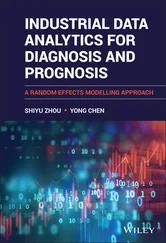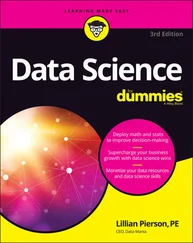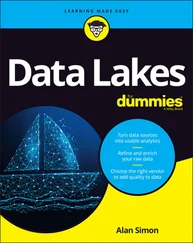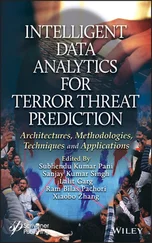3 Part 1: Intro to Analytics and Blockchain Part 1
Chapter 1: Driving Business with Data and Analytics Chapter 1
Deriving Value from Data Deriving Value from Data The increased trend toward personalized offerings both depends on data and exposes data’s importance to business operations. Data is no longer simply a consequence of engaging in transactions — data is necessary to increase the volume of transactions. Organizations are learning how valuable data is to their capability to conduct and expand operations. If you want to stay competitive in today’s economy, you’ll have to provide an experience that's responsive and personal. Data from previous transactions makes it possible to anticipate subsequent activity and tailor offerings to customer and partner preferences. For example, the items you’ve bought online in the past give online shopping sites such as Amazon.com enough of your background to be able to make suggestions for additional purchases. Using past data to recommend future purchase or actions is a common way to derive value from data. In this section, I introduce three ways organizations can identify data with the greatest potential value.
Understanding and Satisfying Regulatory Requirements Understanding and Satisfying Regulatory Requirements The information age offers many new opportunities and just as many (if not more) challenges. The vast amount of data available to organizations of all types empowers advanced decision-making and raises new questions of privacy and ethics. Consumer protection groups have long been voicing concerns about how personal data is being used. In response to discovered abuses and the recognition of potential future abuses, governing bodies around the world have passed regulations and legislation to limit how data is collected and used. Although collecting a few pieces of information about a customer may seem innocent, it doesn’t take long for accumulated data to paint a picture of an individual’s personal characteristics and behavior. Knowing the past behavior of someone makes it relatively easy to predict the person's future actions and choices. Predicting actions has value for marketing but also poses a danger to an individual’s privacy.
Predicting Future Outcomes with Data Predicting Future Outcomes with Data Data can unlock lots of secrets. Data you collect through regular interactions with your customers and business partners can help you understand them and better meet their needs and wants. Assuming you have taken measures to protect individual privacy and have permission to collect and use the data, analyzing that data can benefit your organization and your customers (and partners, too). A common way to use data is to build analytics models that help to explain the data, uncover hidden information, and even predict future behavior. Data analytics is all about using formal methods to unlock secrets that your data is hiding. These secrets aren’t hidden on purpose — they just get lost in the mountains of data you collect. Without a structured approach to examining your data, you might miss some of its value that can lead to increased revenue.
Changing Business Practices to Create Desired Outcomes Changing Business Practices to Create Desired Outcomes Classifying your customers or building models to predict what comes next can help your organization be more responsive to needs. You can use analytics to help plan better and be ready for whatever comes next. But with some additional work, you can do far more with analytics results. Instead of just getting ready for what might happen next, you can use analytics results to alter today’s activities and affect future outcome. Predictive analytics predicts what future results may be. The next step in analytics maturity is prescriptive analytics. With prescriptive analytics, the model identifies changes you can make now to achieve a desired outcome. For example, prescriptive analytics can tell you how many tables to set out in a restaurant or which register lanes to open in a grocery store to meet sales goals. Prescriptive analytics gives organizations the leverage to make operational changes based on their understanding of data that leads to satisfying their goals.
Chapter 2: Digging into Blockchain Technology Chapter 2
Exploring the Blockchain Landscape Exploring the Blockchain Landscape From what you read in books and articles, blockchain technology disrupts everything and fixes every business problem — and both at the same time! This view of blockchain’s omnipotence gives a little too much power to what blockchain can actually do. Blockchain can disrupt the way many business transactions are carried out, but it won’t change everything. Likewise, this new technology can solve some business problems that have been around for a long time, but it doesn’t fit everywhere. The trick is to understand what blockchain can do, and what it can do very well.
Understanding Primary Blockchain Types Understanding Primary Blockchain Types In 2008, Bitcoin was the only blockchain implementation. At that time, Bitcoin and blockchain were synonymous. Now hundreds of different blockchain implementations exist. Each new blockchain implementation emerges to address a particular need and each one is unique. However, blockchains tend to share many features with other blockchains. Before examining blockchain applications and data, it helps to look at their similarities.
Aligning Blockchain Features with Business Requirements Aligning Blockchain Features with Business Requirements Blockchain technology is revolutionary because it provides features not found in other technologies. It doesn’t solve all your computing problems and shouldn’t be part of every application. In fact, blockchain’s unique features address only a small subset of the many problems most enterprises face. Unfortunately, too many organizations choose to adopt blockchain technology and then try to find a place to put it. A far better approach is to understand what blockchain does well and then identify unsolved enterprise problems for which blockchain technology would be a good fit.
Examining Blockchain Use Cases Examining Blockchain Use Cases Many good examples of use cases for blockchain technology exist. In this section, you look at just a few. See if you can think of a good blockchain use case in your own organization.
Chapter 3: Identifying Blockchain Data with Value Chapter 3
Exploring Blockchain Data Exploring Blockchain Data In this section, you discover what data gets stored in blocks on a blockchain. Although each blockchain implementation differs in its low-level details, the concepts are generally consistent across blockchain types. Because the purpose of this book is to introduce you to the most important concepts of blockchain analytics, I won’t cover the specific technical details of every blockchain. Instead, you learn about the specific features of the most popular public blockchain implementation, Ethereum. If you don't use Ethereum, don’t worry — the concepts you learn here will apply easily to any other blockchain implementation. The main difference between the most popular types of blockchain is the way in which they handle transactions. Bitcoin uses the Unspent Transaction Output (UTXO) model, in which each transaction spends some of what was leftover from a previous transaction, and then creates new output that is the remaining (unspent) balance after processing a transaction. The other main approach to handling transactions is the Account/Balance model, which Ethereum uses. In the Account/Balance model, each account has a recorded balance, and transactions add to, or subtract from, that balance. The Account/Balance model is similar to a traditional ledger. I focus on Ethereum and the Account/Balance model in this book.
Categorizing Common Data in a Blockchain Categorizing Common Data in a Blockchain You’ve already seen most of the types of data you’ll use when carrying out blockchain analytics. You’ve seen block header data, basic transaction data, and details contained in some transactions. You may have investigated the Etherscan user interface to view some event data, and even the effect a transaction has on the blockchain state. In this section, you learn more about the main categories of blockchain app data: transaction, events, and state.
Examining Types of Blockchain Data for Value Examining Types of Blockchain Data for Value Now that you know about the basic categories of data a blockchain stores, you can start to dig into what each type of data you’ll find might mean. Few hard-and-fast rules for storing data exist. Each smart contract sets its own rules for defining and maintaining the data it needs to do its work.
Aligning Blockchain Data with Real-World Processes Aligning Blockchain Data with Real-World Processes Although understanding the data available through transactions, events, and contract state is important, you must understand what that data represents before you can make much sense out of it. An important part of any data analytics project (blockchain or traditional data) is to align data with the real world. In a blockchain environment, that understanding starts with smart contracts.
Chapter 4: Implementing Blockchain Analytics in Business
Aligning Analytics with Business Goals
Surveying Options for Your Analytics Lab
Installing the Blockchain Client
Installing the Test Blockchain
Installing the Testing Environment
Installing the IDE
Chapter 5: Interacting with Blockchain Data
Exploring the Blockchain Analytics Ecosystem
Adding Anaconda and Web3.js to Your Lab
Writing a Python Script to Access a Blockchain
Building a Local Blockchain to Analyze
Читать дальше
